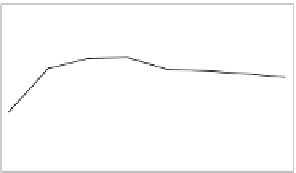Biomedical Engineering Reference
In-Depth Information
1
1
0.8
0.8
0.6
0.6
Dry, no harmonics
Dry, first harmonic
Water, no harmonics
Water, first harmonic
Gel, no harmonics
Gel, first harmonic
Dry, low frequencies
Dry, high frequencies
Water, low frequencies
Water, high frequencies
Gel, low frequencies
Gel, high frequencies
0.4
0.4
0.2
0.2
0
0
12
15
18
21
28
32
36
40
1
2
3
4
5
6
7
8
Frequency [Hz]
Number of electrodes
Fig. 4.
Classification accuracy across three different setups when: a) using first harmonics; b)
different number of electrodes is used
applied PSD-based algorithm (that uses harmonics) to the cases of one to eight elec-
trodes. The results are illustrated in Figure 4b. The figure shows that on average the
accuracy is stable across all setups, if 3 to 6 electrodes were used. Also the accuracy
level when using 2 electrodes is not much lower than when using three or more.
5
Practical Application
This section illustrates the potential of applying the presented setups in the real life
situations. The effect of stimuli duration on the classification rate is addressed in terms
of finding the highest ITR. Then, the impact of replacing the conductive gel ground
electrode with the dry and water-based one is demonstrated. The section finishes with
the discussion on user comfort, convenience, and time required to prepare different
setups for practical use.
5.1
Stimuli Duration and ITR
The increase of average accuracy across three setups when using different stimuli dura-
tion times is illustrated in Figure 5a. In contrast to our expectation, the decrease of accu-
racy was minor when shortening the stimuli period from
5
sto
3
s and not so steep from
3
sto
0
.
75
s. This resulted in very high theoretical bit rates (shown in Figure 5b), going
up to
26
bpm (
1
s stimuli duration) for low and
21
bpm (
0
.
875
s stimuli duration) for high
frequencies with dry setup,
41
bpm (
1
.
5
s stimuli duration) for low and
40
bpm (
0
.
875
s
stimuli duration) for high frequencies with water-based setup, and
69
bpm (
1
.
125
s stim-
uli duration) for low and
65
bpm (
1
.
125
s stimuli duration) for high frequencies with gel
setup.
Although this transfer rates probably cannot be achieved in practice due to transition
effects and the time required for a person to refocus from one stimuli to the other, this
result indicates that even with the technology such as dry or water-based electrodes,
quite good communication speed can be reached, i.e.,
23
bpm for dry and
38
bpm for
water-based electrodes, when averaged over low and high frequency bands. Further-
more, the decrease of the ITR in high frequency range is only minor compared to the
low frequency range ITR.


























































































































































































Search WWH ::

Custom Search